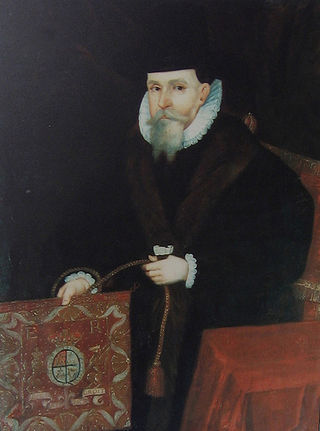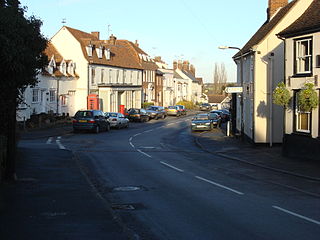Background
He was born at Balreask (or Balrisk), County Meath, son of Thomas Elliott, former Master Gunner for Ireland, and Elizabeth Smart. [1] His sister Margaret was the first wife of Henry Ussher, Archbishop of Armagh. [2] The two men were close friends, and the Archbishop made Elliott co-executor of his will of 1613. [2] Elliott and his second wife Ismay built a church (now a ruin) on the Archbishop's lands at Balsoon in County Meath, and are buried there. [1] Elliott inherited Balreask about 1595. [1]
 Henry Ussher, Archbishop of Armagh, Elliott's brother-in-law
Henry Ussher, Archbishop of Armagh, Elliott's brother-in-law
Career
The date of his call to the Bar is uncertain, but he is recorded as a member of Lincoln's Inn in 1587. He was then made Clerk of the Crown for four counties of Ulster. [1] He was appointed a Baron of the Exchequer in 1590, and was praised for his hard work and diligence. [1] During the Nine Years War, he was sent to negotiate with the Gaelic leader Hugh O'Neill, 2nd Earl of Tyrone in 1596. Following the establishment of the Irish Assize system in 1603-4, he went on circuit regularly as a judge of assize. [1] This no doubt raised his credit with the English Crown, which complained that many judges were reluctant to travel outside Dublin. He was knighted in 1609. [1]
In 1607 the King's Inns, after a hiatus of some years, was revived. [3] Elliott became Treasurer of the Inns in the same year. [3] He was the first member of the Inns to have a barrister's chambers "the first that began to build a chamber in the King's Inns", [3] and as a special privilege three of his sons, who were described as "attorneys", were allowed to share the chambers. [3] They also had their fees remitted, in recognition of Sir John's services to the Inns. He served as Treasurer until 1610. [3]
During the Flight of the Earls he and his colleague Sir Christopher Sibthorpe of the Court of King's Bench (Ireland) were sent to Ulster in the winter of 1607 with the formal indictment for rebellion against Tyrone and Rory O'Donnell, 1st Earl of Tyrconnell. [1] During the Parliament of 1613-15 he attended with his colleague, Sir William Sparke of the Court of King's Bench, before the House of Lords to act as their legal advisor, a role commonly performed by the High Court judges at the time. [1]
Marriages and children
He married four times and had issue by his second marriage. [4] His first wife was Joan Might, daughter of Thomas Might. [1] His second wife was Ismay Rochfort, daughter of Christopher Rochfort of Kilbryde, County Meath and his wife Margaret Lynch. [4] They had four sons, Henry, Thomas, Oliver and Christopher, [4] three of whom followed their father into the legal profession. [3] His third wife, whom he married after 1602, was Archbishop Ussher's cousin Eleanor Ussher, daughter of Alderman Robert Ussher of Santry and his first wife Margaret Fitzjohn. She was the widow of Walter Ball, Mayor of Dublin (died 1598) and of Dr. Robert Conway, Master in the Court of Chancery (Ireland) (died 1602). [1] Eleanor died in 1613, and Sir John made a fourth marriage to Alice Kennedy, daughter of Hugh Kennedy of Dublin and widow of John Arthur. [1]

Adam Loftus was Archbishop of Armagh, and later Dublin, and Lord Chancellor of Ireland from 1581. He was also the first Provost of Trinity College Dublin.

Henry Ussher was an Irish Protestant churchman, a founder of Trinity College Dublin, and Church of Ireland Archbishop of Armagh.

Christopher Hampton (1552–1625) was an Englishman who was the Church of Ireland Archbishop of Armagh from 1613 to 1625.
John Garvey (1527–1595) was an Irish Protestant Bishop of Kilmore and Archbishop of Armagh.
Robert Ussher (1592–1642) was an Irish Protestant Provost of Trinity College Dublin and Bishop of Kildare.
Joseph Deane PC (1674–1715) was an Irish politician and judge who became Chief Baron of the Irish Exchequer. His sudden and premature death was popularly believed to be due to a chill caught when watching an eclipse of the sun.

John Bathe was an Irish barrister and judge. He was a member of a famous legal dynasty, and had a distinguished career under the Tudors, holding office as Solicitor General for Ireland and Chief Justice of the Irish Common Pleas.
Sir Thomas Rochfort (c.1450-1522) was a distinguished Irish judge and cleric who held the offices of Solicitor General for Ireland, Master of the Rolls in Ireland, and Dean of St. Patrick's Cathedral.
The Rochfort family came to Ireland in the thirteenth century and acquired substantial lands in counties Kildare, Meath and Westmeath. Several members of the family were prominent lawyers and politicians. They gained the title Earl of Belvedere, and gave their name to the village of Rochfortbridge. The main Rochfort line ended with the death of the 2nd Earl of Belvedere in 1814.
Sir John Cornwalsh, or Cornwalysch was an Irish judge who held the office of Chief Baron of the Irish Exchequer. His tenure was notable for the fact that he succeeded his father as Chief Baron, and for his long struggle to retain the office in defiance of a rival claimant, Michael Gryffin. He is also remembered as the builder of Dardistown Castle in County Meath.
Richard Segrave (c.1540–1598) was an Irish judge, remembered chiefly for sitting in judgement on his colleague Nicholas Nugent, who was the only Irish judge ever to be hanged for treason by the Government which appointed him.
Sir John Blennerhassett was an English-born judge and politician who became Chief Baron of the Irish Exchequer and sat in the Irish House of Commons as MP for Belfast. He was a member of a prominent Norfolk family which acquired large estates in Ireland, mainly in County Fermanagh. The Blennerhassett family have an enduring connection with County Kerry.
Sir John Everard was an Irish barrister, politician and judge. He was notable as the last Irish judge until the reign of James II to openly profess the Roman Catholic faith. His religious beliefs eventually led to his enforced resignation from the Bench in 1607. He then entered politics and was a member of the Irish Parliament of 1613–1615. The Catholic members elected him as speaker of the House of Commons and installed him in the speaker's chair, but due to the creation of new pocket boroughs by James I, the Protestants had the majority and elected Sir John Davies. Everard, in a farcical scene, initially refused to vacate the chair until he was literally sat upon, which caused him to fall into disgrace for a time, but he was later restored to royal favour. His second son Sir Richard Everard was created the first of the Everard baronets of Ballyboy.
Luke Ussher was Archdeacon of Armagh from 1622 until his death on 6 November 1632.

Nicholas Kerdiffe was an Irish barrister and Law Officer of the early seventeenth century.
William Hilton was an Irish politician, barrister and judge. He is now mainly remembered for his family connection to James Ussher, Archbishop of Armagh, whose sister Anne he married, and who furthered his career.
Sir Samuel Mayart (1587–c.1646) was an English-born judge in seventeenth-century Ireland, who also had some reputation as a political theorist.

Sir Christopher Sibthorpe was an English-born lawyer who had a distinguished career in Ireland as a judge and politician, and was also a religious writer of some note.

Sir William Sparke was an English-born judge in Ireland, whose memorial can still be seen in St. Audoen's Church, Dublin.
This page is based on this
Wikipedia article Text is available under the
CC BY-SA 4.0 license; additional terms may apply.
Images, videos and audio are available under their respective licenses.
 Henry Ussher, Archbishop of Armagh, Elliott's brother-in-law
Henry Ussher, Archbishop of Armagh, Elliott's brother-in-law





